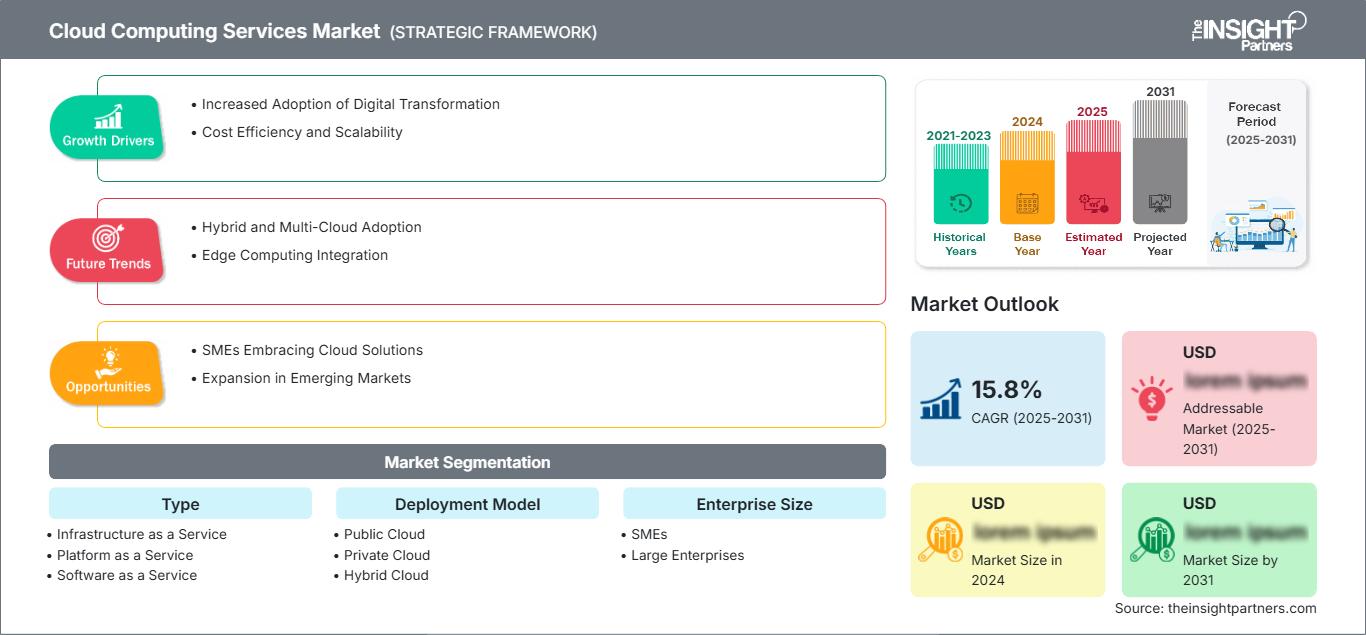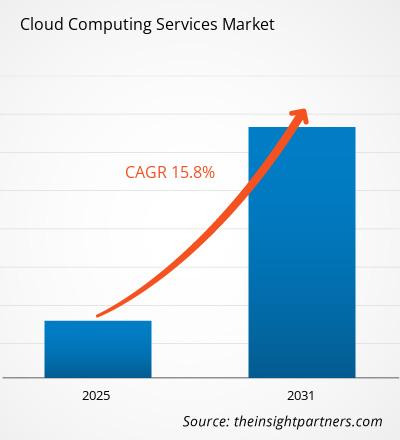Si prevede che il mercato dei servizi di cloud computing raggiungerà i 2011,54 miliardi di dollari entro il 2031. Si prevede che il mercato registrerà un CAGR del 16,5% nel periodo 2025-2031.
Il rapporto è segmentato per tipologia (Infrastructure as a Service (IaaS), Platform as a Service (PaaS), Software as a Service (SaaS)); modello di distribuzione (cloud pubblico, cloud privato, cloud ibrido); dimensione aziendale (PMI, grandi imprese); settore dell'utente finale (BFSI, IT e telecomunicazioni, governo e settore pubblico, beni di consumo e vendita al dettaglio, produzione, energia e servizi di pubblica utilità, media e intrattenimento, sanità e scienze della vita, altri). L'analisi globale è ulteriormente suddivisa a livello regionale e per paesi principali. Il rapporto offre il valore in USD per l'analisi e i segmenti sopra indicati.
Scopo del rapporto
Il rapporto "Cloud Computing Services Market" di The Insight Partners mira a descrivere il panorama attuale e la crescita futura, i principali fattori trainanti, le sfide e le opportunità. Ciò fornirà spunti a vari stakeholder aziendali, come:
- Fornitori/Produttori di tecnologia: per comprendere le dinamiche di mercato in evoluzione e conoscere le potenziali opportunità di crescita, consentendo loro di prendere decisioni strategiche informate.
- Investitori: per condurre un'analisi completa delle tendenze in merito al tasso di crescita del mercato, alle proiezioni finanziarie di mercato e alle opportunità esistenti lungo la catena del valore.
- Organismi di regolamentazione: per regolamentare le politiche e le attività di controllo sul mercato con l'obiettivo di ridurre al minimo gli abusi, preservare la fiducia degli investitori e sostenere l'integrità e la stabilità del mercato.
Tipo di segmentazione del mercato dei servizi di cloud computing
- Infrastruttura come servizio
- Piattaforma come servizio
- Software come servizio
Modello di distribuzione
- Cloud pubblico
- Cloud privato
- Cloud ibrido
Dimensione aziendale
- PMI
- Grandi imprese
Settore dell'utente finale
- BFSI
- IT e telecomunicazioni
- Pubblica amministrazione e settore pubblico
- Beni di consumo e vendita al dettaglio
- Produzione
- Energia e servizi di pubblica utilità
- Media e intrattenimento
- Sanità e scienze della vita
- Altri
Potrai personalizzare gratuitamente qualsiasi rapporto, comprese parti di questo rapporto, o analisi a livello di paese, pacchetto dati Excel, oltre a usufruire di grandi offerte e sconti per start-up e università
Mercato dei servizi di cloud computing: Approfondimenti strategici

-
Ottieni le principali tendenze chiave del mercato di questo rapporto.Questo campione GRATUITO includerà l'analisi dei dati, che vanno dalle tendenze di mercato alle stime e alle previsioni.
Fattori di crescita del mercato dei servizi di cloud computing
- Maggiore adozione della trasformazione digitale: la crescente tendenza alla trasformazione digitale in tutti i settori sta trainando il mercato dei servizi di cloud computing. Le organizzazioni stanno spostando la propria infrastruttura IT sul cloud per ottenere maggiore scalabilità, efficienza dei costi e agilità. I servizi cloud consentono alle aziende di adottare tecnologie innovative, semplificare le operazioni e migliorare l'esperienza dei clienti, il che sta favorendo l'adozione diffusa del cloud e accelerando la crescita del mercato.
- Efficienza dei costi e scalabilità: i servizi di cloud computing offrono significativi vantaggi in termini di costi eliminando la necessità di costose infrastrutture on-premise. Le aziende pagano solo per le risorse che utilizzano, consentendo loro di aumentare o ridurre i servizi in base alla domanda. Questo modello pay-as-you-go rende le soluzioni cloud più interessanti sia per le grandi aziende che per le PMI, stimolando la crescita del mercato dei servizi di cloud computing.
Trend futuri del mercato dei servizi di cloud computing
- Adozione di cloud ibrido e multi-cloud: una tendenza chiave nel mercato dei servizi di cloud computing è la crescente adozione di strategie ibride e multi-cloud. Le organizzazioni stanno integrando soluzioni cloud pubbliche e private per ottimizzare flessibilità, prestazioni e gestione del rischio. Questo approccio consente alle aziende di diversificare la propria infrastruttura cloud, prevenire il lock-in con un singolo fornitore e soddisfare specifici requisiti normativi o di sicurezza dei dati, favorendo un'ulteriore adozione del cloud.
- Integrazione dell'Edge Computing: l'integrazione dell'edge computing con i servizi cloud sta guadagnando terreno, soprattutto nei settori che richiedono bassa latenza ed elaborazione dei dati in tempo reale. L'edge computing avvicina l'elaborazione dei dati alla fonte, migliorando l'efficienza dei servizi cloud. Questa tendenza è particolarmente rilevante in settori come l'IoT, la produzione e i veicoli autonomi, dove l'elaborazione rapida dei dati e il minimo ritardo sono fondamentali.
Opportunità di mercato per i servizi di cloud computing
- Le PMI adottano soluzioni cloud: le piccole e medie imprese (PMI) stanno adottando sempre più servizi di cloud computing per migliorare l'efficienza operativa e ridurre i costi IT. Le piattaforme cloud offrono alle PMI l'accesso a risorse e tecnologie informatiche avanzate che un tempo erano accessibili solo alle organizzazioni più grandi. Questa crescente adozione offre significative opportunità ai provider di servizi cloud per sviluppare soluzioni personalizzate e scalabili per le PMI, alimentando l'espansione del mercato.
- Espansione nei mercati emergenti: i mercati emergenti, in particolare in Asia-Pacifico, Africa e America Latina, rappresentano un'importante opportunità di crescita per il mercato dei servizi di cloud computing. Con il miglioramento dell'infrastruttura Internet e la trasformazione digitale delle aziende in queste regioni, la domanda di servizi cloud è in forte aumento. Adattare le offerte alle esigenze aziendali locali, ai quadri normativi e ai requisiti di sovranità dei dati può aiutare i fornitori di servizi cloud a sfruttare questi mercati in rapida crescita.
Mercato dei servizi di cloud computing
Le tendenze regionali e i fattori che influenzano il mercato dei servizi di cloud computing durante il periodo di previsione sono stati ampiamente spiegati dagli analisti di The Insight Partners. Questa sezione illustra anche i segmenti di mercato e la geografia della gestione delle malattie del ritmo cardiaco in Nord America, Europa, Asia-Pacifico, Medio Oriente e Africa, America meridionale e centrale.
Ambito del rapporto di mercato sui servizi di cloud computing
| Attributo del rapporto | Dettagli |
|---|---|
| Dimensioni del mercato in 2024 | US$ XX Billion |
| Dimensioni del mercato per 2031 | US$ 2011.54 Billion |
| CAGR globale (2025 - 2031) | 16.5% |
| Dati storici | 2021-2023 |
| Periodo di previsione | 2025-2031 |
| Segmenti coperti |
By Tipologia
|
| Regioni e paesi coperti |
Nord America
|
| Leader di mercato e profili aziendali chiave |
|
Densità degli operatori del mercato dei servizi di cloud computing: comprendere il suo impatto sulle dinamiche aziendali
Il mercato dei servizi di cloud computing è in rapida crescita, trainato dalla crescente domanda degli utenti finali, dovuta a fattori quali l'evoluzione delle preferenze dei consumatori, i progressi tecnologici e una maggiore consapevolezza dei vantaggi del prodotto. Con l'aumento della domanda, le aziende stanno ampliando la propria offerta, innovando per soddisfare le esigenze dei consumatori e sfruttando le tendenze emergenti, alimentando ulteriormente la crescita del mercato.

- Ottieni il Mercato dei servizi di cloud computing Panoramica dei principali attori chiave
Punti di forza
- Copertura completa: il rapporto analizza in modo esaustivo prodotti, servizi, tipologie e utenti finali del mercato dei servizi di cloud computing, offrendo una panoramica olistica.
- Analisi degli esperti: il rapporto è redatto sulla base della conoscenza approfondita di esperti e analisti del settore.
- Informazioni aggiornate: il rapporto garantisce la pertinenza aziendale grazie alla copertura di informazioni e tendenze dei dati recenti.
- Opzioni di personalizzazione: questo rapporto può essere personalizzato per soddisfare le esigenze specifiche del cliente e adattarsi in modo appropriato alle strategie aziendali.
Il rapporto di ricerca sul mercato dei servizi di cloud computing può quindi contribuire a guidare il percorso di decodificazione e comprensione dello scenario del settore e delle prospettive di crescita. Sebbene possano esserci alcune preoccupazioni valide, i vantaggi complessivi di questo rapporto tendono a superare gli svantaggi.
- Analisi storica (2 anni), anno base, previsione (7 anni) con CAGR
- Analisi PEST e SWOT
- Valore/volume delle dimensioni del mercato - Globale, Regionale, Nazionale
- Industria e panorama competitivo
- Set di dati Excel
Report recenti
Testimonianze
Motivo dell'acquisto
- Processo decisionale informato
- Comprensione delle dinamiche di mercato
- Analisi competitiva
- Analisi dei clienti
- Previsioni di mercato
- Mitigazione del rischio
- Pianificazione strategica
- Giustificazione degli investimenti
- Identificazione dei mercati emergenti
- Miglioramento delle strategie di marketing
- Aumento dell'efficienza operativa
- Allineamento alle tendenze normative






















 Ottieni un campione gratuito per - Mercato dei servizi di cloud computing
Ottieni un campione gratuito per - Mercato dei servizi di cloud computing